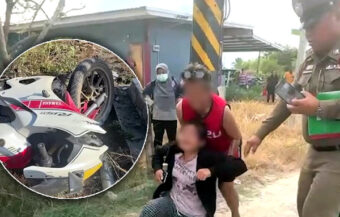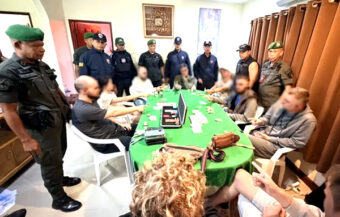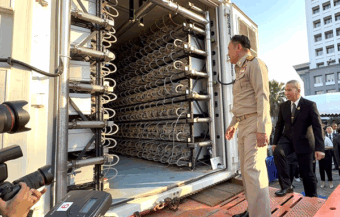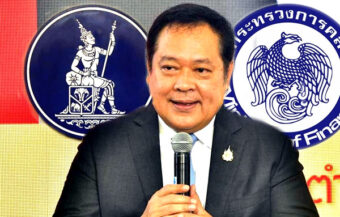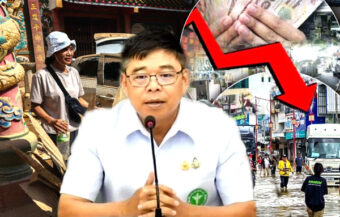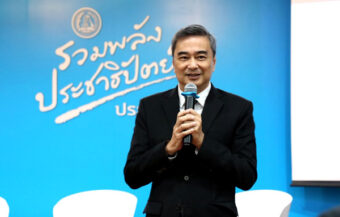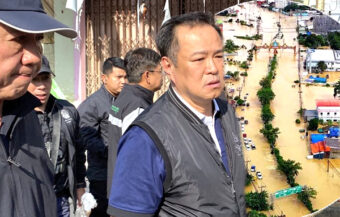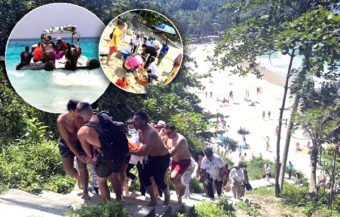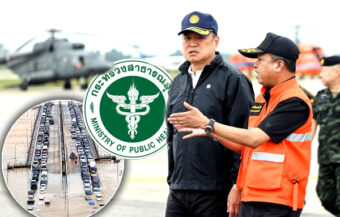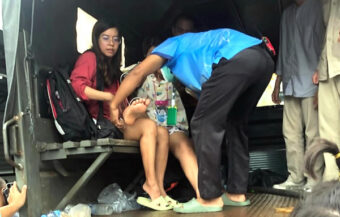Thailand’s military defence expenditure has not been above the NATO recommended level of 2% of GDP since 1997, the year of the Asian Financial Crisis. This year it is projected to be 1.22% or even lower but just above a historic low of 1.05% in 2005 under the popular government of Thaksin Shinawatra which consistently cut spending on arms.
After three years of economic malaise and two years of the COVID-19 virus crisis, Thailand is pulling back on government expenditure in 2022 and the country’s military budget is experiencing its third year of decline to one of the lowest expenditure to GDP ratios in the kingdom’s history. This is coming at a time of increased tensions and instability in the Asia Pacific as China and the United States appear increasingly at odds. In a week when the Royal Thai Air Force put forward its plans to purchase eight F35 fighter jets from the US, the question must be asked, what is Thailand’s defence strategy and against whom will it be defending itself against?
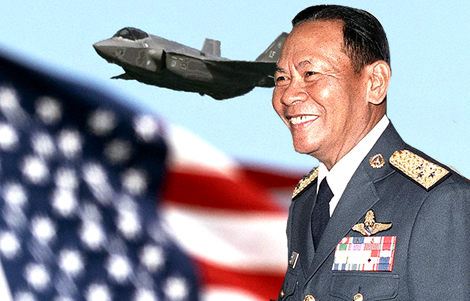
This week, Air Chief Marshal Napadej Dhupatemiya of the Royal Thai Air Force put forward the air force’s case for the purchase of eight state of the art F35 fighter jets from the United States in a transaction that could cost the kingdom somewhere between $560 million and $648 million or up to ฿21.51 billion in what the air force commander described as a good deal considering the alternative Swedish Saab Gripen jets would cost $670 million or ฿22.24 billion while noting the former price of what is arguably the world’s most sophisticated fighter jet had previously been set at up to $142 million each.
The F35, manufactured by Lockheed Martin in partnership with Northrop Grumman and BAE Systems is a single-engine, single-seater and multi-role fighter aircraft that uses stealth technology and is envisaged by US military planners to be in service for the next 50 years.
First deployed by the US Marine Corps and now the mainstay of US airpower, the F35 is the gold standard
First deployed by the US Marine corps in 2015, the F35 is now the main component of US airpower across the Marine Corps, US Navy and US Air Force. The F35 is currently the gold standard in fighter jet technology.
Announcing the plan to purchase the new aircraft which the Air Force proposes to base in Nakhon Ratchasima, Air Chief Marshal Napadej also explained that planners within the service have come up with a proposal to use the new jets while supported by an unmanned aircraft called the ‘Loyal Wingman’ developed by the Australian Air Force and US aircraft manufacturer Boeing.
‘We don’t require a full fleet of F35 jets. We may use just eight to 12 and use drones to fly alongside the manned aircraft,’ Air Chief Marshal Napadej outlined.
The proposal is sure to meet with resistance from opposition political parties who have long urged the Thai government to reduce military expenditure in the light of a poorly performing economy and the COVID-19 crisis.
Last year the Royal Thai Navy deferred the purchase of Chinese Yuan class submarines due to public pressure
Last year, in June, Prime Minister Prayut Chan ocha who is also Defence Minister, asked the Royal Thai Navy to defer its plans to purchase two Chinese made Yuan-class S26T submarines at a cost of ฿22.5 billion until this year in the face of a rising chorus of political opposition and public anger over the move which took to social media to make itself known.
Chinese submarine payments deferred again by PM as funding is needed to manage the crisis
Thailand, for three years in a row now, has reduced its military defence budget in the face of a poorly performing economy and the COVID-19 crisis.
Indeed, the kingdom’s military budget for 2021/2022 is only expected to be 1.22% of GDP or $6.16 billion which is a figure that appears more like military budgets pursued by the governments of the Thaksin era when military spending sunk to 1.05% in 2005, a historic low according to World Bank data.
Thailand last saw military expenditure above 2% of GDP in 1997 before the Asian Financial Crisis
The kingdom last saw its expenditure to GDP level rise above 2% which is the average advised by NATO to its members to maintain an adequate state of defence readiness in 1997 at 2.174% before the budget was cut after the Asian Financial Crisis in 1997 and 1998.
It has never reached that height again.
Speaking to the media this week, Air Chief Marshal Napadej said: ‘If the air force receives support from the public, including politicians, and if we can afford it, it will move to upgrade and strengthen its airpower.’
Kingdom’s growing economic relationship and friendly ties with China, seen formerly as the enemy during the cold war, has undermined the imperative
China was seen before 1979 as Thailand’s natural enemy as the kingdom adopted a defensive posture against the threat of communism from Beijing, other regional players and an internal insurgency sponsored by the Communist Party-state.
The question of Thailand’s military readiness to defend itself has largely lost its significance in the last four to five decades as the country’s relationship with China has grown stronger with more of an emphasis on fostering increased trade and a stronger economic relationship.
In 2003, however, Thailand was designated by the United States officially as a major non-NATO ally for the purpose of the Foreign Assistance Act 1961 whereby the US provides support to allied nations to assist with economic development and to bolster both internal and external security.
Thailand has grown closer to China since the 2006 and 2014 coups which strained its US alliance
Nonetheless, most observers now accept that the kingdom has, since then, grown closer to China in terms of the power dynamics of Southeast Asia particularly since the 2006 coup and even more so since the second coup of the 21st century in 2014 both of which overthrew democratically elected governments which came to power led by a member of the Shinawatra political dynasty in Thailand.
Both coups disrupted and negatively impacted the kingdom’s relationship and longstanding alliance with the United States which remains firmly committed to upholding democratic principles and human rights in the Asia Pacific.
This week, as he presented the planned expenditure by the air force, Air Chief Marshal Napadej, emphasised that this project was not one aimed at buying weaponry but was part of the air force’s mission to defend the people and their interests.
Who is the enemy in 2022? What is Thailand’s defence strategy as regional tensions rise to danger levels?
Even with lower levels of military expenditure undercut by a fluttering economy and the virus crisis, the question must be asked, against whom is the military defending the kingdom? Is there, at this stage, a coherent and viable strategy especially given the rising tensions in Southeast Asia since early 2020?
To get some insight into this, we have to go back to comments made by former army chief General Apirat Kongsompong who in 2019 told Reuters that the Thai military was engaged in a struggle against what he termed ‘communists’ and described the threat from them as ‘hybrid warfare’.
He was speaking after 5 small explosive devices went off in Bangkok on the 2nd of August 2019.
‘It’s like cyber warfare. And when it combines with the incident that happened last week, it’s like hybrid warfare,’ General Apirat explained. ‘Now it is not just an open enemy like the old time. So we have to reorganise and improve our knowledge, and reorganise our units and many things to maintain peace and national security.’
Army chief in 2019 identified ‘communistic thinking’ from universities as a key threat to national stability
General Apirat who trained extensively in the United States, at one point, was considered by security analysts as a champion of the kingdom’s alliance with America, in speech after speech during his tenure as army chief made no secret that he saw one of the main threats to Thailand as ‘communistic thinking’ emerging from universities.
Army Chief draws a line on opposition moves to alter the 2017 constitution in a passionate speech
At the same time, the government led by the current Prime Minister, Prayut Chan ocha, has forged deeper and closer ties with communist China including stronger economic ties and bilateral military cooperation.
It is all a far cry from 1979 when military expenditure in Thailand as a percentage of GDP was 4.38% and the main objective was the containment of communist movements in Southeast Asia.
Policy of economic development and elimination of cold war tensions became the general consensus
Indeed, all Thai governments have pursued such a policy in recent decades encouraged by international agencies with the admirable goal of boosting economic development and eliminating cold war-era tensions.
This gained added impetus in December 2001 when China became a member of the World Trade Organisation.
This was the accepted consensus in a growing multilateral world order before the 2016 popular revolution in western countries and the election of Donald Trump as President of the United States driven by a grassroots movement in America, the United Kingdom and Europe.
Conflict may be brewing between the United States supported by its allies in the Asia Pacific and China
Today, as Thai authorities show a greater interest in Beijing’s growing arsenal of authoritarian technology such as facial recognition databases, draconian internet laws and smart cities where surveillance is integrated, the kingdom finds itself in the midst of an emerging crisis in the region as the United States and its western allies are increasingly pushing back at efforts by Communist China to dominate.
This worrying scenario has seen many respected commentators highlight the rising possibility of a military confrontation between China and western alliances led by the United States with the likely flashpoint being Taiwan.
Thailand’s reduced defence budget has come about due to straitened circumstances and not policy
The lower level of military expenditure by Thailand has come about not by policy design in recent years but rather by straitened economic circumstances as the government in Bangkok has had to husband its resources to deal with the COVID-19 virus and before this the downturn caused by the US-Chinese trade war which began in 2019.
Since the Biden presidency, this war has been tamped down somewhat although the Washington administration since January last year has continued to adopt a tough line with Beijing which appears also to be suffering from a controlled but increasingly disturbing internal economic crisis with financial analysts concerned about a slow-motion collapse within the regional banking and property sector which could undermine stability in China and pose a threat to the current Communist Party-led regime.
This development coming in parallel with a rapidly deteriorating relationship between China and western powers led by the United States is a cause of grave concern.
Worrying developments in Cambodia and Myanmar for Bangkok in addition to the rising Chinese threat
In addition, Thailand must also be anxious about growing threats from China including its heightened influence within Cambodia and growing cooperation between Phnom Penh and Beijing including the clandestine development of the Ream Naval Base and intelligence reports of a growing Chinese military presence in the neighbouring kingdom effectively ruled by a dictator.
Added to this is the growing instability and crisis in Myanmar where a civilian uprising and state of civil war with the military establishment has already, in December, overspilt into Thailand with Myanmar’s air force bombing rebel targets on Christmas Eve which sent hundreds across the border.
Against this, the kingdom’s defence budget has shrunk for three years in a row.
Thailand maintains a large standing army and reserve by its retention of conscription and national service
According to recent figures, 49% of Thailand’s budget of only $6.16 billion in 2021/2022 will be spent on the army while 20.3% will be spent on the Royal Thai Navy and 18.9% on the Royal Thai Air Force.
The balance is spent on the armed forces command and the Institute of Defence Technology, a defence research and technology unit operated by the Thai armed forces.
The Ministry of Defence, this year, through spokesman Police Lieutenant General Kongcheep Tantravanich was anxious to underline that a lower budget for 2021/2022 comes in the context of a wider cut of 5.66% in public expenditure in 2022 as the kingdom’s Ministry of Finance moves to rein in public finances after last year’s unprecedented level of fiscal stimulus to the economy.
Thailand’s armed forces retain 360,850 active duty personnel with a further 200,000 in reserve. This is a significant number from a population of 69.8 million according to 2020 estimates.
The kingdom has retained compulsory military conscription and a national service requirement despite the opposition’s call for a smaller, volunteer and more professional force.
China’s stated expenditure on defence is 1.7% of GDP although there are doubts about the authenticity of this figure as with much of the data from Beijing
However, this year’s expenditure of $6.16 billion is 1.23% of GDP based on 2020’s GDP or 1.22% based on the projected GDP for 2021 which only grew marginally by 1%.
China, in 2020, spent $250 billion on defence or 1.7% of its GDP. The Communist nation commands armed forces of 2.185 million personnel with a potential force on call of up to 4 million.
Significantly, there is some ambiguity and indeed mystery over the figures for Chinese military expenditure which has remained constant for many years and which many observers suspect, like a lot of other data emerging from China, is deliberately skewed for political, propaganda or security purposes.
The published figure is just less than a third of that spent by the United States which diverts 3.7% of its GDP annually towards defence and security.
China’s military has surpassed the US in shipbuilding, missiles and air defence systems, all vital for a potential invasion of Taiwan says the Pentagon
The latest assessment by the Pentagon in Washington, which has been studying Chinese military capability since 2000, has concluded that China has, in fact, overtaken the United States in several key areas such as shipbuilding, ballistic and cruise missiles as well as integrated air defence systems.
The US defence hawks have noted that this is precisely the capability that China needs for a successful attack and invasion of Taiwan which senior military leaders have warned the US Congress could be imminent or happen within the next four to five years, certainly within the current decade.
In March 2021, Admiral Philip S Davidson, the retiring commander in the Indo-Pacific told the US Senate Armed Services Committee that China’s ambitions extended even beyond Taiwan and that its goal was similar to Japan’s before 1941 which was to supplant the role of the United States in the Asia Pacific.
Former US service chief in Asia Pacific believes the threat from China is both real and imminent
‘I worry that they are accelerating their ambitions to supplant the United States,’ Admiral Davidson said. ‘Taiwan is clearly one of their ambitions before then, and I think the threat is manifest during this decade, in fact, in the next six years.’
The question for Thailand and its Ministry of Defence is what role will Thailand play in any possible or forthcoming conflict between these two powers. Or in the light of this week’s proposal from the Royal Thai Air Force, how might the proposed F35 fighters be deployed?
Lowering of US flag in Chengdu is a wake-up call for foreigners living in Thailand and with close ties here
At present Thailand is playing its customary hedging game between both powers, a foreign policy that has served the kingdom well in the past when confronted by rival powers for dominance in the region.
More assertive tone and spirit from the United States and allies may put pressure on Thailand’s traditional hedging posture between powerful super powers
The United States and western allies increasingly showed in 2021, a willingness to confront China whose position is looking increasingly under threat economically.
There is a more urgent line emanating from Washington as it is becoming clear that China is determined to play its own role according to its own rulebook.
For Thailand, this may mean the days of its hedging policy are numbered.
While the elites of Southeast Asia who have so much to lose if war or even a limited military conflagration breaks out, and much of the diplomatic corps talk down the prospect of all-out war between the two world superpowers, there is an increasing realisation that the policies and paths being pursued by China and the United States are diametrically opposed.
China, as its economic edifice built up over the last two decades begins to reveal widening cracks, has reportedly shifted towards increasingly autocratic methods of governing including its response to the current economic situation which is anathema to the western concept of democracy, free markets and the rule of law.
Troubling future for the Asia Pacific region and expats in Thailand as the kingdom’s position is obscure
As well as Taiwan and China’s ruthless suppression of democracy and former liberties in Hong Kong, the treatment of the Uigur Muslim population in Xinjiang province is fast becoming a red line among western populations already aggravated by the COVID-19 catastrophe for which many blame Beijing.
For a growing number of observers including western expats in Thailand, the future looks troubling as we enter a period of heightened tension over the coming years which look increasingly dangerous for the region.
Thailand’s role appears uncertain or perhaps deliberately obscure.
This is certainly the case in its track record on defence including military hardware purchases and access to its bases and facilities.
While China’s relationship with Thailand, at least up to 2019, was seen as in the ascendant, the fact that the kingdom has maintained its alliance with the United States and its ongoing cooperation with the US military and authorities should not be overlooked.
Join the Thai News forum, follow Thai Examiner on Facebook here
Receive all our stories as they come out on Telegram here
Follow Thai Examiner here
Further reading:
China could be an economic time bomb sitting on Thailand’s doorstep as Evergrande collapse nears
With Omicron hovering, firms already suffering a cash flow crunch with the economy again in peril
UK Foreign Secretary visits Bangkok after AUKUS security pact further raises tensions with China
Trade pact with Hong Kong as Thailand negotiates both Chinese and new western trade relationships
US Ambassador resigns as Biden Presidency starts with growing tensions with China over Taiwan
RCEP deal agreed as India opts out – busy Bangkok ASEAN summit concludes on a low key
Chinese FM to visit Thailand in a Covid battered world of raised tensions and potential conflict
Prime Minister indicates that the cabinet reshuffle will be complete very shortly with no problem
Thailand’s economy has become dependent on government expenditure to stay above water
Thailand and US aim for a new more ‘proactive’ trading relationship as ambassador meets Prayuth
Rice price spike but drought conditions to recede – security concern for the Mekong river
US suspension of Thai preferential trade partner status part of Trump’s ongoing trade war


